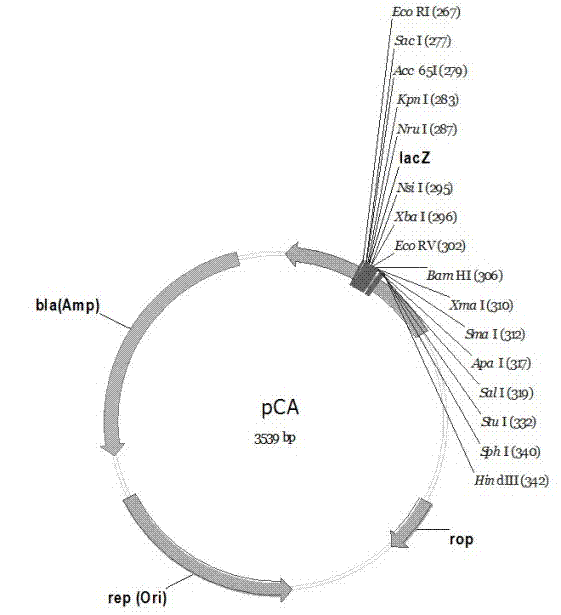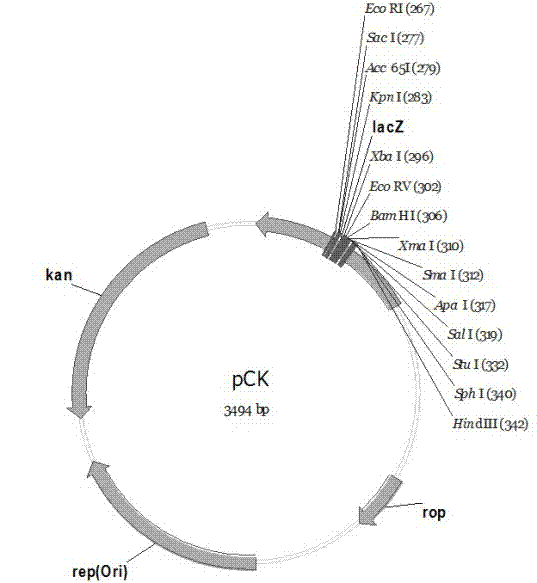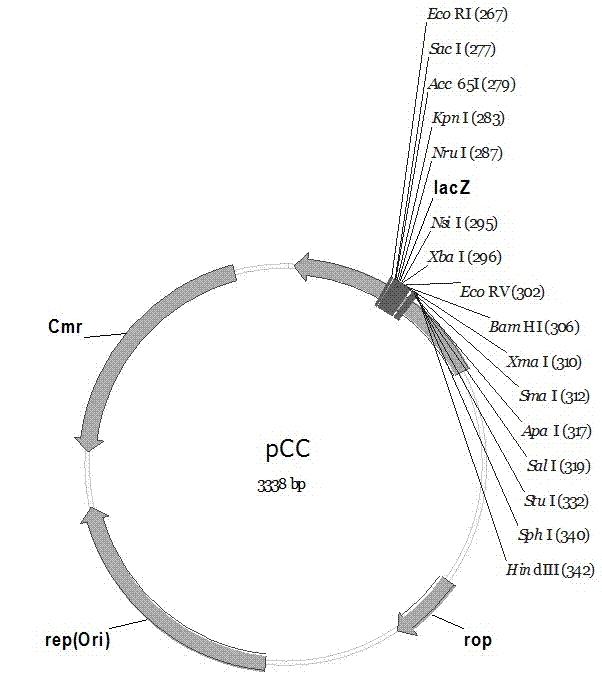PC series plasmid as well as construction method and application thereof
A plasmid and series of technologies, applied in the field of biotechnology and genetic engineering, can solve the problems of low success rate of large fragment gene cloning, limited length of cloned gene fragments, low stability of high-copy plasmids, etc., and achieve high stability and molecular weight. Small, large-capacity effect
- Summary
- Abstract
- Description
- Claims
- Application Information
AI Technical Summary
Problems solved by technology
Method used
Image
Examples
Embodiment 1
[0047] Embodiment 1: Construction of plasmid pCA
[0048] The schematic diagram of the construction process of plasmid pCA is as follows: Figure 4 As shown, the specific method is as follows:
[0049] 1. Design and synthesize the lacZ gene, the full-length sequence is 588bp, of which 104~141 are the CAP binding region, 181~217 are the operator genes, 226~573 are the 5'-part gene sequence of the β-galactosidase gene, 243~ 323 is the multiple cloning site region. Gene sequence such as sequence 4 in the sequence listing;
[0050] 2. Design and synthesize the rop gene, the full length of the sequence is 822bp, of which the sequence 611-782 is the rop gene, which encodes the rop protein, and the gene sequence is as sequence 5 in the sequence list;
[0051] 3. Design and synthesize the rep replicon gene, with a full-length sequence of 1080bp, of which 22-689 are replicon rep genes, DNA replication start site 447 (+ / -) position, the gene sequence is as sequence 6 in the sequence ...
Embodiment 2
[0076] Embodiment 2: Construction of plasmid pCK
[0077] Change the antibiotic resistance gene on the basis of plasmid pCA to construct the plasmid pCK with kanamycin resistance, the specific method is as follows:
[0078] 1. Artificially design and synthesize the kan gene fragment, with a total length of 850 bases, of which bases 22-837 are the coding region of the kan gene. The sequence of the kan gene fragment is shown as sequence 8 in the sequence list, and the synthesized Kan electrophoresis is shown in Figure 6A , where 1 is the PCR result of the synthetic kan gene, and 2 is Marker DS5000. This figure shows that the spliced gene fragment is the same as the design;
[0079] 2. Design primers P6 and P7 to amplify the part of the plasmid pCA other than the bla gene (lacZ-rop-rep). According to the designed primers, the two ends of the amplified gene fragment contain overlapping and complementary sequences with the two ends of the kan gene ;
[0080] The sequences of...
Embodiment 3
[0094] Embodiment 3: Construction of plasmid pCC
[0095] The construction method of plasmid pCC is the same as the construction method of plasmid pCK in Example 2. First, the Cmr gene is synthesized, and then primers are designed to amplify the lacZ-rop-rep gene fragment from pCA, and then the Cmr gene is reversely spliced into the pCA gene The 3'-end of the fragment lacZ-rop-rep forms a linear lacZ-rop-rep-Cmr gene fragment, and finally the linear gene fragment is circularized into a circular plasmid pCC by homologous recombination.
[0096] The numbering of the bases in the plasmid pCC is the same as that of pCA and pCK. The first base T at the 5'-end of the complementary sequence of the lacZ gene fragment is used as the starting base of the plasmid sequence. The total length of the plasmid is 3338 base pairs. The sequencing results It shows that the constructed circular plasmid pCC is consistent with the expectation, and the Cmr gene is located at the position of 2539bp~...
PUM
 Login to View More
Login to View More Abstract
Description
Claims
Application Information
 Login to View More
Login to View More - R&D
- Intellectual Property
- Life Sciences
- Materials
- Tech Scout
- Unparalleled Data Quality
- Higher Quality Content
- 60% Fewer Hallucinations
Browse by: Latest US Patents, China's latest patents, Technical Efficacy Thesaurus, Application Domain, Technology Topic, Popular Technical Reports.
© 2025 PatSnap. All rights reserved.Legal|Privacy policy|Modern Slavery Act Transparency Statement|Sitemap|About US| Contact US: help@patsnap.com



